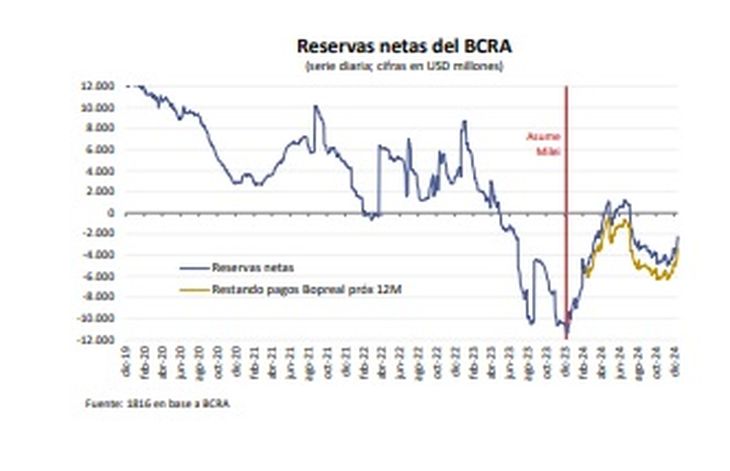Thus, this week the Argentine exchange market is experiencing a new dollar buying wavewhich weakened the weight in the different currency trading venues and to the Central Bank (BCRA) as liquidity controller. In the city, they argue that the trend falls within the typical repositioning of investment portfolios at the end of the year, to which is added the devaluation of the real as a condition in regional trade.
And, as he explains well Adrian Yarde Buller, chief strategist Facimex Securitiesin dialogue with Scope, since December 11, the peso depreciated almost 9%“well above other currencies in the region, which were also punished, such as those of Brazil, Chile and Colombia.”
However, the strategist is clear in pointing out that we should not oversize the movements and, above all, also put some perspective. “So far this quarter, the weight got strongereven in nominal terms, while other currencies, such as those of Brazil or Chile, suffered depreciations close to 10%.”
Real vs. Weight: the intervention
The latest report of Personal Investment Portfolio (PPI) ensures that the volume operated in AL30 and GD30 in CCL and MEP t+1 “remained at atypical levels.” After US$277 million were operated on Wednesday (record volume for the year), on Thursday operations were US$159 million.
“Both figures contrast notably with the December average of US$60 million and US$61 million since October, excluding the volume of the last two days. Without monetary data yet to confirm it, these volumes suggest that there was an official presence“, concludes the document.
And he adds: “We infer that the BCRA would have intervened in the financial market on Monday. According to our estimates, on December 17, BCRA would have contracted US$26,004 millionequivalent to approximately US$23 million dollars, attributable to the “Others” factor of the Monetary Base.
It should be noted that the majority of operations in this market are settled with a term of t+1, which implies that this absorption of pesos would correspond to operations carried out on December 16. Furthermore, considering that the BCRA would not have a position in futures (at least until the end of October), PPI deduces that “Much of this contraction would be linked to interventions in the MEP and CCL markets.“.
PPI.jfif
It should be noted that Brazil has more than US$300,000 million in reserves. And that, despite its delicate situation with debt in local currency, debt in foreign currency is negligible, since it barely represents 4% of the Gross Domestic Product (GDP). This gives a notable backing to the Central Bank to intervene in the exchange rate, something that a few weeks ago did not seem very willing, but the current situation does not seem to have left it any option.
Meanwhile, at the local level, where the BCRA burned US$50 million -according to private estimates- to avoid a more pronounced devaluation. This generates a net loss of reserves, a limited resource in a context in which they are at negative levels. However, this type of strategies is considered necessary to avoid destabilizing movements in the exchange market.
Leonardo Anzalone, director of the Center for Political and Economic Studies (Cepec), explains in statements to this medium that the behavior of the CCL dollar, which closed last Friday at $1,092 and rose to $1,157 until this Thursday, implies a nominal devaluation of 6% in less than a week.
1816.jpg

The economist warns that This adjustment is well above the average depreciation of 2.6% observed in currencies of emerging economies during the same period and highlights the relative vulnerability of the Argentine peso.
“In comparison, the Brazilian real, which had gone through turbulent weeks, managed to appreciate 0.61% during the last week, while currencies such as the Chinese yuan and the Mexican peso they showed no changes. Which shows the weakness this week for the local currency,” indicates the economist.
The economist Federico Glustein qualifies with Anzalone and points out that, this week, the official exchange rate did not experience significant changes, in fact, it even appreciated, since the real moved 5.4%, while parallel quotes in Argentina rose 6.8% %, “which implies that the effect on the official exchange rate was less than 2%.”
Therefore, it is ruled that Argentina in terms of the CCL was the most punished at the regional level this weekbut in annual terms, the real depreciated 24%, while the CCL has depreciated by 19%, this, in nominal terms. “In real terms, we are above 30%,” he says. For his part, Anzalone concludes that in this way the peso was the most punished currency in the region this week.
The factors behind weight punishment
The analyst attributes the punishment to the weight of three factors. The first is the recent reduction in the interest rate, which impacts the exchange rate. He estimates that the intention behind this decision was to put upward pressure on the exchange rate gap, which was at historically low levels. Added to this element is the seasonal demand for vacations. And, “lastly, The situation in Brazil impacted, with the fall of the real“says Anzalone.
For his part, Glustein indicates that, if it were not for the intervention of the Government in the parallelsthe peso could continue with a downward trend in the coming weeks, at least, “until seasonal demand eases and then stabilizes.” And he concludes in line with Anzalone: ”The loss of value of the real plays an important factor, which, today, seems to have no floor.”
In this regard, the report of Consultant 1816 states that “The Government is expected to intervene to prevent further increases in the exchange ratetaking advantage of the recent accumulation of dollars by the BCRA and the increase in the Broad Monetary Base.”
Source: Ambito
I am a 24-year-old writer and journalist who has been working in the news industry for the past two years. I write primarily about market news, so if you’re looking for insights into what’s going on in the stock market or economic indicators, you’ve come to the right place. I also dabble in writing articles on lifestyle trends and pop culture news.




